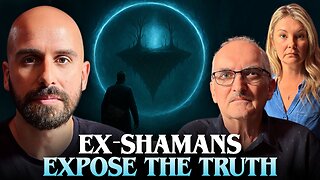Premium Only Content

Exploring the Enormous: NASA's Animation Unveils Supermassive Black Holes
Embark on a journey through the cosmos as NASA's captivating animation delves into the awe-inspiring world of supermassive black holes. These colossal cosmic entities reside at the hearts of galaxies, including our own Milky Way, boasting a staggering mass that can range from hundreds of thousands to tens of billions of times that of our Sun.
In this visually stunning animation, witness the intriguing phenomenon surrounding these supermassive black holes. As any form of light ventures beyond the event horizon—the point of no return—it becomes forever imprisoned, while light grazing its vicinity is dramatically bent by the black hole's immense gravitational force. The result is a profound "shadow" that extends to about twice the size of the black hole's actual event horizon.
Our cosmic tour introduces you to ten of these supermassive black holes, each taking center stage in their respective galaxies, from the familiar Milky Way to the colossal M87. As we journey outward from the vicinity of our Sun, the camera gradually pulls back, providing a fascinating comparison between these celestial behemoths and various structures within our solar system.
Meet 1601+3113, a dwarf galaxy housing a black hole with the mass equivalent to 100,000 Suns. Here, the matter is so densely packed that even the black hole's shadow appears smaller than our own Sun.
Next up, we arrive at the heart of our galaxy, Sagittarius A*, weighing in at a colossal 4.3 million times the mass of our Sun. Its shadow spans approximately half the size of Mercury's orbit in our solar system.
Marvel at the two massive black holes residing within the galaxy NGC 7727, separated by a distance of 1,600 light-years. One weighs an astonishing 6 million solar masses, while the other exceeds 150 million Suns. Astronomers predict their eventual merger, anticipated to occur within the next 250 million years.
As we scale up the animation, we reach M87's black hole, now estimated to possess the mass of 5.4 billion Suns. Its shadow is so vast that even a beam of light, hurtling at a staggering speed of 670 million mph (1 billion kph), would take around two and a half days to traverse it.
Our cosmic odyssey concludes with TON 618, one of the few distant and immensely massive black holes for which astronomers have direct measurements. This cosmic titan boasts an astonishing mass of over 60 billion solar masses, accompanied by a shadow so immense that it would take weeks for a beam of light to traverse its colossal expanse. Join us as we unlock the mysteries of the universe's most enigmatic and colossal creations—supermassive black holes.
Music credit: "In the Stars" from Universal Production Music
Credit: NASA's Goddard Space Flight Center Conceptual Image Lab
Lead Producer: Scott Wiessinger (KBRwyle)
Lead Animator: Krystofer Kim (KBRwyle)
Lead Science writer: Francis Reddy (University of Maryland College Park)
Visualizer: Jeremy Schnittman (NASA/GSFC)
Producer: Sophia Roberts (AIMM)
Scientist: Jeremy Schnittman (NASA/GSFC)
-
 LIVE
LIVE
SOLTEKGG
5 hours ago🔴LIVE - BATTLEROYALE - BF6 Giveaway
41 watching -
 LIVE
LIVE
Spartan
5 hours agoLies of P and then not sure
42 watching -
 1:41:35
1:41:35
The Quartering
2 hours agoCharlie Kirk Assassin Gets Big Win, Food Riots Coming, ICE Drops Gaming Meme & Breaks Internet
93.3K38 -
 3:23:22
3:23:22
The Confessionals
3 hours agoThey Crossed Realms Doing Soul Retrievals (and paid the price)
1991 -
 9:12
9:12
China Uncensored
4 hours agoChina's EV DISASTER
5633 -
 LIVE
LIVE
Badlands Media
13 hours agoGeopolitics with Ghost Ep. 52 - October 28, 2025
1,198 watching -
 1:07:04
1:07:04
Timcast
4 hours agoFood Stamps ENDING, Riots Feared, National Guard Says DEFY Trump's ORDERS
154K237 -
 2:03:13
2:03:13
Steven Crowder
6 hours agoDave Smith: Discussing Trump, Israel, & America First
429K603 -
 49:56
49:56
The Rubin Report
5 hours agoA Chilling Warning for America & Why Trump’s Tariffs Have Backfired | Yaron Brook
55.4K39 -
 17:36
17:36
Bearing
7 hours agoHARD-ASS Police Boss GOES TO WAR With VIOLENT LEFTISTS 🚨🚔
20.5K35